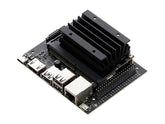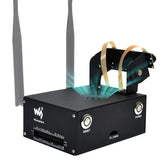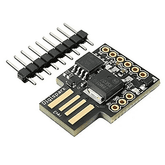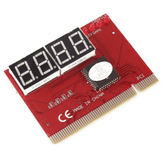How to use Jetson Nano
Summary
Unlock the power of AI with our comprehensive guide on using Jetson Nano. Start with an introduction to this compact yet powerful AI development board. Learn how to set up your Jetson Nano, including hardware assembly and software installation. Dive into configuring the Jetson Nano for optimal performance. Explore its capabilities in computer vision and deep learning, with practical examples and applications. Perfect for beginners and AI enthusiasts, this guide will help you harness the full potential of Jetson Nano. Click now to start your AI journey with Jetson Nano!
Introduction
In the realm of single-board computers, the Jetson Nano stands out as a formidable powerhouse designed by NVIDIA. It's not just another little computer; rather, it's a game-changer that opens up new possibilities for edge computing applications and deep learning research for developers, enthusiasts, and hobbyists.
Grasping the Jetson Nano's capabilities and its distinct place in the tech industry are the first steps towards comprehending it. For demanding computational operations, especially those requiring artificial intelligence (AI) and machine learning (ML), the Jetson Nano is designed, in contrast to typical single-board computers, which are primarily designed for fundamental computing tasks.

The importance of this differential lies in the fact it elevates the Jetson Nano from a toy for idle exploration to a competitive option for tasks requiring strong processing capability in a small package. At the core of its appeal lies NVIDIA's expertise in GPU (Graphics Processing Unit) technology, which is leveraged to accelerate AI workloads. With real-time processing and decision-making being crucial in applications like computer vision, autonomous robotics, and edge computing, the Jetson Nano is ideally suited for these kinds of uses.
Compared to conventional CPU-based systems, developers can obtain considerable speedups in model training and inference by utilizing the capabilities of CUDA (Compute Unified Device Architecture) and cuDNN (CUDA Deep Neural Network library). The Jetson Nano is made with ease of use in mind in addition to its high computer capacity. NVIDIA offers software tools and complete developer kits that make setup and programming easier.
Through NVIDIA's support ecosystem, users can easily become up to speed and begin working on their projects without being hampered by technical difficulties, from flashing the operating system to establishing development environments. Additionally, the Jetson Nano promotes an innovation strategy driven by the community. Through forums, tutorials, and open-source projects, NVIDIA actively promotes teamwork and knowledge exchange. In addition to improving the educational process, this collaborative attitude quickens the development of edge computing and artificial intelligence applications.
The Jetson Nano's architecture performs admirably in these taxing situations, in contrast to traditional single-board computers that might find it difficult to handle complex AI tasks. Its unique capabilities, including as its capacity to manage intricate neural networks and process data in real time, allow developers to push the envelope of computing capabilities.
Whether you're a seasoned developer looking to prototype an autonomous drone or a student eager to explore the fundamentals of deep learning, the Jetson Nano offers a versatile platform to transform ideas into reality. This blog will guide you through the essential steps of setting up, configuring, and harnessing the Jetson Nano's capabilities for various applications. By the end, you'll have the confidence and knowledge to embark on your own AI-driven projects, empowered by the unparalleled performance and flexibility of the Jetson Nano.
Setting Up the Jetson Nano
Setting up your Jetson Nano is a crucial first step to unleash its powerful capabilities for AI and edge computing applications. This section provides a detailed walkthrough to ensure you have your Jetson Nano up and running smoothly.
Unboxing and Initial Inspection:
Begin by unboxing your Jetson Nano developer kit. Inside, you should find the Jetson Nano module itself, along with necessary accessories such as a power supply, microSD card (if applicable), and various connectors. Take a moment to inspect each item to ensure everything is included and undamaged.
Assembling the Hardware:
Depending on your developer kit, you may need to assemble the Jetson Nano module onto its carrier board. This typically involves aligning the module with the connector on the carrier board and gently pressing them together until they are securely connected. Ensure that all connections are firm but do not force anything.
Connecting Peripherals:
Prepare your peripherals such as a keyboard, mouse, and monitor. The Jetson Nano supports HDMI output, so connect your monitor using an HDMI cable. For input devices, connect your keyboard and mouse via USB ports. If you're using a Wi-Fi connection, ensure you have a compatible Wi-Fi adapter ready for setup.
Flashing the Operating System:
The next crucial step is to prepare the microSD card with the Jetson Nano Developer Kit SD Card Image. Visit NVIDIA’s official website and download the latest SD card image for your Jetson Nano model.
https://developer.nvidia.com/embedded/downloads
Once downloaded, you'll need to flash this image onto the microSD card using a tool like Etcher (available for Windows, macOS, and Linux).


Insert the microSD card into your computer’s card reader.
Open Etcher and select the downloaded SD card image file.
Choose the correct microSD card drive and click 'Flash' to start the process.
This will overwrite any existing data on the microSD card, so ensure you have backed up any important files.
Inserting the microSD Card:
Once the flashing process is complete, safely eject the microSD card from your computer and insert it into the microSD card slot on the Jetson Nano carrier board. This microSD card will serve as the primary storage for the Jetson Nano's operating system and applications.
Powering On the Jetson Nano:
With the microSD card inserted, connect the provided power supply to the Jetson Nano's power jack. NVIDIA recommends using a 5V⎓4A power supply with a 2.1mm barrel jack connector for optimal performance. Once connected, power on the Jetson Nano by pressing the power button or by applying power through the power adapter.
Initial Boot and Setup:



Upon powering on, the Jetson Nano will boot up and initialize the operating system from the microSD card. Follow the on-screen prompts to set up the basic system configuration. This may include selecting language preferences, configuring network settings (Wi-Fi or Ethernet), and setting up user accounts.
Updating System Software:
Once the initial setup is complete, it’s essential to update the system software to ensure you have the latest drivers, libraries, and security patches.

Open a terminal window and run the following commands to update the system:
sudo apt update
sudo apt upgrade
Follow any prompts to confirm the updates and allow the system to download and install the necessary packages. This step ensures that your Jetson Nano is equipped with the latest enhancements and bug fixes.
Configuring the Jetson Nano
Configuring your Jetson Nano involves optimizing its settings and installing necessary software tools:
Installing Development Tools:
• Set up the NVIDIA SDK Manager to install essential development tools and libraries. • Install CUDA and cuDNN for GPU-accelerated computing capabilities.
Setting Up Environment Variables:
Configure environment variables such as PATH and LD_LIBRARY_PATH for seamless integration with development frameworks.
Testing GPU and CPU Performance:
Run benchmarks to ensure the Jetson Nano is operating at its peak performance levels.
Adjust settings as needed for specific use cases and applications.
Using the Jetson Nano for Computer Vision and Deep Learning
The Jetson Nano excels in applications involving computer vision and deep learning due to its GPU capabilities and CUDA support:
Installing AI Frameworks:
Install popular frameworks like TensorFlow, PyTorch, or OpenCV to leverage the Jetson Nano's GPU for accelerated model training and inference.
Running Pre-trained Models:
Utilize pre-trained models for tasks such as object detection, image classification, and semantic segmentation.
Evaluate model performance and fine-tune parameters for specific requirements.
Deploying Edge AI Applications:
Develop and deploy edge AI applications that can run autonomously on the Jetson Nano.
Integrate with sensors and peripherals for real-time data processing and decision-making.
Conclusion
The Jetson Nano is a doorway to the edge computing and artificial intelligence of the future, not merely a small form factor computer. We've covered how this NVIDIA single-board computer enables experts, enthusiasts, and developers to easily and effectively dive into complex AI and deep learning applications throughout this tutorial.
Complex algorithms may be processed in real time at the edge with the Jetson Nano thanks to its GPU-accelerated computing capacity. In applications like autonomous vehicles, industrial automation, and intelligent surveillance systems, where latency is vital, this capacity is essential. By guaranteeing data privacy and operational efficiency in delicate contexts, the capability to implement AI models directly on the device lessens dependency on cloud computing.
The Jetson Nano also shines in terms of adaptability. Its easy incorporation into current development workflows is made possible by its support for well-known AI frameworks like TensorFlow, PyTorch, and OpenCV. The Jetson Nano has the computational power required to handle these tasks efficiently, whether you're studying natural language processing, applying object detection methods, or training neural networks for image identification.
The Jetson Nano not only excels technically but also nurtures a thriving developer and innovation ecosystem. NVIDIA's dedication to open-source cooperation and ongoing development promotes information exchange and quickens the development of edge AI. applications. Engaging with this community not only expands one's skill set but also opens doors to potential collaborations and creative partnerships that can drive groundbreaking advancements in AI technology.
It appears that the Jetson Nano will have a significant influence on how intelligent systems and smart products are developed in the future. The need for effective, scalable edge computing solutions will only increase as AI begins to seep into more sectors of the economy and daily life. AI capabilities may be integrated into a variety of applications, from retail and entertainment to healthcare and agriculture, thanks to the Jetson Nano's small size, energy economy, and reliable performance.
Conclusively, the Jetson Nano enables researchers to push the boundaries of AI innovation and entrepreneurs to create next-generation IoT devices by realizing their innovative ideas. You will be ready to take on innovative projects that fully utilize AI at the edge if you can successfully set up, configure, and use the Jetson Nano as described in this guide. Use the Jetson Nano as your go-to tool to embrace the possibilities, discover new areas, and connect with others who are pushing the boundaries of edge computing and artificial intelligence.












